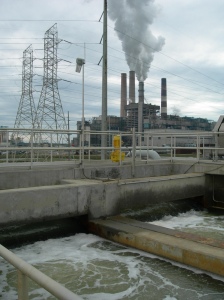Part 2 of a series.
By John Earl
OC Voice
Huntington Beach City Councilmember Don Hansen reassured the public. “I’m actually pretty comfortable having a private company potentially evaluate the dedication of a source for our future water supply,” he said.

The Tampa Bay, Florida desalination plant: A series of failures and costly delays. Photo: http://www.treehuggers.org
That was three years ago at a city council meeting when Hansen and three other council members, Cathy Green, Gil Coerper and Keith Bohr (now Mayor Bohr) voted to allow Poseidon Resources Inc. to build a desalination plant at the corner of Newland and Beach avenues in southeast Huntington Beach.
If all goes according to plan, the facility would convert 127 million gallons of seawater into 50 million gallons of fresh drinking water every day of the year. The city would have the option of buying up to 3.5 million gallons of that water at a discount compared to the cost of imported water (two-thirds of the city’s water comes from ground wells, its cheapest source of water). The rest would be distributed throughout the Municipal Water District of Orange County (MWDOC), in theory, to provide a guaranteed water source to help offset drought conditions in the state.
The plant still needs approval from the State Lands Commission and the California Coastal Commission and Poseidon still lacks the private and public financing needed to build and operate, although Poseidon officials say that all are forthcoming (see Part 1).
No matter if the Huntington Beach desalination plant fails, Bohr said, because the burden will be strictly Poseidon’s. “We’re not hiring Poseidon, so there’s no risk,” he told hundreds of people packed tightly into the city council chambers. “If it fails, it doesn’t cost us anything.”
But Poseidon’s facility in Tampa Bay, Florida, it’s first (and failed) attempt to build and operate a desalination plant, is used by opponents to argue against building the Huntington Beach desalination plant.
The Tampa Bay desalination plant, about half the size of the one planned for Huntington Beach, has operated improperly if at all since it opened in 2003. (more…)


